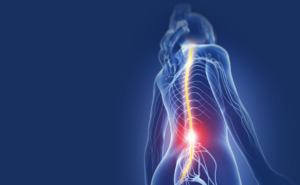Anterior Lumbar Interbody Fusion (ALIF)

What’s Anterior Lumbar Interbody Fusion (ALIF)?
The medical term ‘Anterior Lumbar Interbody Fusion’ refers to a surgical procedure used to treat certain conditions affecting the lumbar spine (lower back). The surgery involves approaching the spine from the front (anterior) of the body and fusing two or more vertebrae together using a bone graft or an interbody cage device. ALIF’s primary objective revolves around stabilizing the spine, relieve pain, and address conditions such as disc degeneration, spinal instability, or certain types of disc herniations.
During this surgical procedure, the neurosurgeon locates the levels of vertebrae requiring fusion through an incision in the front of the belly. The neurosurgeon will then remove the intervertebral disc and place a bone graft in its place to relieve nerve pinching and restore the patient’s height. During the healing process after the surgery, the vertebral bones will fuse into one solid piece. The theory behind every spinal fusion procedure remains that a painful vertebral segment should stop hurting when excessive motion seizes in that area.
What are the Conditions for Anterior Lumbar Interbody Fusion?
A neurosurgeon may recommend Anterior Lumbar Interbody Fusion to a patient with severe low back pain caused by degenerative disc disease. This surgical procedure may also prove helpful to relieve pain in conditions including:
5- Persistent spinal instability that has failed to respond to other non-surgical alternatives
A neurosurgeon may not recommend Anterior Lumbar Interbody Fusion for patients with medical conditions that will prevent or prolong bone fusion. These conditions may include severe osteoporosis, obesity, severe atherosclerosis of the aorta, or a significant prior abdominal surgery.
How do Neurosurgeons carry out Anterior Lumbar Interbody Fusion?
Performing an Anterior Lumbar Interbody Fusion (ALIF) procedure is a meticulous and intricate task within the realm of neurosurgery. This surgical technique involves a skilled neurosurgeon accessing the lumbar spine through an anterior approach, typically the abdominal region. The surgeon delicately navigates through layers of tissue and structures, meticulously ensuring the protection of vital organs and blood vessels. Once a precise path is established, the damaged disc in the spine is carefully removed, making space for an interbody cage, often containing bone graft material. This cage serves as a stabilizing scaffold to facilitate spinal fusion, promoting the growth of new bone and fusion between adjacent vertebrae. The procedure demands a profound understanding of spinal anatomy, surgical dexterity, and a judicious approach to minimize potential risks. Neurosurgeons must harmonize cutting-edge technology with their expertise to ensure the success of an ALIF procedure, aiming to alleviate pain, restore spinal stability, and enhance patients’ quality of life.
What’s expected during the recovery period from Anterior Lumbar Interbody Fusion?
After the Anterior Lumbar Interbody Fusion procedure, a nurse will monitor the respiration rate, blood pressure, and heart rate of the patient. A little pain after this procedure especially at the incision site usually occurs and the surgeon may prescribe pain medications to provide some relief. The patient should take note to make regular body movements some hours after the surgery to avoid blood clot formation in the legs and improve normal circulation.
The surgeon will mostly carry out a CT scan the next day to confirm the position of the screws. The patient will typically get discharged after a short period of post-surgical care. Total recovery time usually takes about six to twelve weeks and regular x-ray sessions may occur to confirm a successful fusion.
What are the Possible Risks and Complications of Anterior Lumbar Interbody Fusion?
Similar to every other surgical procedure, an Anterior Lumbar Interbody Fusion surgery comes with a couple of risks. Possible complications related to spinal fusion surgeries include bleeding, nerve damage, infection, paralysis, and failure of the vertebral bones to fuse. Specific complications that may occur after the Anterior Lumbar Interbody Fusion procedure include injury to abdominal organs or large blood vessels, retrograde ejaculation, and bone graft migration.
ALIF suits conditions necessitating anterior decompression, restoration of disc height, and/or segmental stabilization. It proves favorable when the spine’s posterior (back) structures remain intact and don’t necessitate surgical intervention. Typically, the procedure leads to reduced post-operative pain and shorter hospital stays in comparison to specific posterior approaches.
As with any surgery, ALIF involves potential risks and complications, and not all patients fit the criteria. To determine the most suitable course of action for an individual’s specific condition, it’s crucial to undergo a comprehensive evaluation conducted by a qualified spine surgeon. This evaluation will help determine whether ALIF or an alternative treatment option best fits choice.
Xu DS, Walker CT, Uribe JS. Minimally invasive anterior, lateral, and oblique lumbar interbody fusion: a literature review. Ann Transl Med 6(6):104, 2018
Stauffer RN, Coventry MB. Anterior interbody lumbar spine fusion. Analysis of Mayo Clinic series. J Bone Joint Surg Am. 1972;54(4):756-768.
Jackson KL, Yeoman C, Chung WM, Chappuis JL, Freedman B. Anterior lumbar interbody fusion: two-year results with a modular interbody device. Asian Spine J. 2014;8(5):591-598. doi:10.4184/asj.2014.8.5.591
Laratta JL, Davis EG, Glassman SD, Dimar JR. The transperitoneal approach for anterior lumbar interbody fusion at L5-S1: a technical note. J Spine Surg. 2018;4(2):459-460. doi:10.21037/jss.2018.05.18
